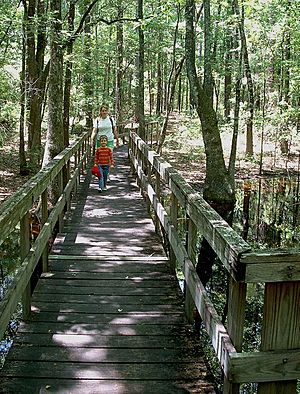Leon Sinks Geological Area facts for kids
The Leon Sinks Geological Area is a special place in southern Leon County, Florida, United States. It's part of the Woodville Karst Plain, which is an area made of soft rock that water can easily flow through. This creates amazing underground caves and sinkholes.
Leon Sinks is home to one of the biggest underwater cave systems in the world. It's even connected to Wakulla Springs, another famous natural spot. This whole system is like a giant underground river network.
Because the ground here is very porous, water can easily seep into the underground system. This means the water system is very sensitive to pollution. Scientists from the Woodville Karst Plain Project have spent a lot of time exploring and mapping these caves. They do this to understand how the system works and how to protect its clean water.
The Leon Sinks area is full of unique creatures. You can find freshwater eels here. There are also rare crustaceans, like the Woodville Karst Plain crayfish and a tiny swimming creature called the Florida cave isopod (Remasellus parvus). These special animals can only be found in the Woodville Karst Plain.
Contents
What is the Wakulla-Leon Sinks Cave System?
The Wakulla cave system is a huge network of underground water tunnels. Imagine long, connected tubes, usually about 300 feet (91 meters) deep. Some parts open up into larger rooms. So far, over 12 miles (19 kilometers) of these tunnels have been mapped!
The main tunnel stretches south from the Wakulla Springs entrance for more than 3.8 miles (6.1 kilometers). Several smaller tunnels, including those from Leon Sinks, connect to this main one. Most of these connecting tunnels have been fully explored.
On December 15, 2007, something exciting happened. Explorers from the Woodville Karst Plain Project found a connection between the Wakulla cave system and the Leon Sinks cave system. This discovery created the Wakulla-Leon Sinks Cave System. It became the longest underwater cave in the United States! It's also the sixth longest in the entire world, with a total of 31.99 miles (51.48 kilometers) of mapped passages.
Exploring Sinkholes at Leon Sinks
The Leon Sinks Geological Area has many sinkholes. A sinkhole is a hole in the ground that forms when the surface layer collapses into an underground cave. Many of these sinkholes are connected by the underwater caves. You can find both wet and dry sinkholes here.
Wet Sinkholes
Wet sinkholes have water in them, often leading to the underground cave system.
- Big Dismal: This sinkhole has a 100-foot (30-meter) drop to the water. The water itself is another 100 feet (30 meters) deep, with a cave entrance 80 feet (24 meters) down.
- Black
- Duckweed
- Fisher Creek
- Hammock (also known as Little Dismal)
- Lost Stream
- Magnolia
- Natural Bridge
Dry Sinkholes
Dry sinkholes are depressions in the ground that do not contain water.
- Back
- Big Eight
- Cone
- Far
- Field
- Gopher Hole
- Johnson
- Palmetto
- Tiny
- Turner
Park and Hiking Trails
The Leon Sinks Geological Area is also a great place for hiking and exploring nature. There are three main hiking trails that lead to different sinkholes in the park. You can even find an observation platform at Big Dismal Sink, offering a great view.
As you walk the trails, you'll see over 20 different types of trees and 75 different plants. Keep an eye out for wildlife too! You might spot birds like Carolina chickadees or even gopher tortoises walking around.
Here are the trails you can explore:
- Sinkhole Trail: 3.1 miles (5.0 kilometers) long
- Gumswamp Trail: 2.3 miles (3.7 kilometers) long
- Crossover Trail: 0.5 miles (0.8 kilometers) long



